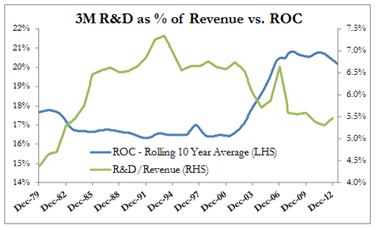Can we ever compete with the likes of Apple, Intel, GlaxoSmithKline or Bayer? If we stop to think, probably not, and the reason is no other than their competitive advantage: patents. And, even if we wanted to compete, we would have to invest vast quantities of money each year in R&D (Research and Development). To be precise, Apple invested 4,500 million dollars last year, Intel 10,000, Glaxo 6,100 and Bayer 4,200. Quantities that when well invested, can give very good results.
This competitive advantage was well defined by Warren Buffett: it is the moat around a castle. If we imagine the castle is a business, it would be very well defended if its competitive advantages (the moat) were deep and lasting. And these advantages mean that the company will be able to apply higher prices, sell more products, or obtain better cost benefits, ultimately, greater profits than its rivals. That is the reason why companies with good managers tend to invest in R&D, to aim to obtain a competitive advantage.
So why it is good to invest in R&D? Well the answer is simple: to obtain a patent, improved productivity, or cost benefits. In other words, to increase sales, and as a result, profits. At the same time, if you increase sales, you will be able to allocate more money to R&D, because if you keep the same R&D percentage on sales, in relative values (percentage) it is maintained, but not in absolute values (monetary amounts), which increases. And then, if you increase the money you allocate to R&D, you will have greater capacity to obtain new products, better productivity or cost benefits. And back to the start again, better sales will mean more money to allocate to R&D which will then increase sales, and so on.
However this situation is not produced from one day to the next; it requires two important factors: stability and perseverance. Stability because R&D projects need years to develop (for example, in medicine or biology projects) and perseverance because they need consistency, they cannot be put on hold for a while (an experiment cannot be stopped for a year and then re-started). A good example of stability and perseverance is the company 3M, an American company that started in 1905 as a mining company, 3M comes from Minnesota Mining and Manufacturing Company, and thanks to R&D it was transformed into what it is today, an industrial company with countless products. In graph 1, we can observe the relationship between greater R&D investment and greater profitability. This relationship is neither direct nor immediate, but it does tell us something: perseverance and consistency will pay off.
Graph 1. 3M’s Investment in R+D and the relationship with profitability
 Source: 3M. ROC: Return on Capital (left axis). R&D/revenue: R&D/sales (right axis)
Source: 3M. ROC: Return on Capital (left axis). R&D/revenue: R&D/sales (right axis)
Another example of competitive advantage is Intel. This global leader in microchips allocates 10,000 million dollars to R&D each year, double that of its closest competitor, Qualcomm, which allocates 4,900, and much more than AMD or ASML who allocate 1,200. This allows Intel to allocate a greater amount of resources than their competitors, and therefore allows them to defend their situation better than the rest. Even if AMD or ASML were to overshadow them (because of a better patent, etc.), they could still allocate 10,000 million to buying these companies (AMD capitalizes 2,800 million dollars and ASML 38,000 million). This would be an example of how the big fish eats up the little one.
By this I don’t mean it is not possible to compete with the big ones. In 2004, Apple invested little more than 500 million dollars in R&D, and from this amount iPhones and iPads materialized, as well as new Macs that allowed Apple to transform itself into what it is today, one of the major global companies. Today, it has gone from investing 500 to more than 4,500 million in R&D, an amount that even though it has increased significantly, it has gone from representing 6.3% of sales in 2004, to 2.4% in 2013. This would be an example of the fast fish eating up the slow one, it’s better late than never and quality is more important than quantity.
Summing up, the important thing is to have great ideas that allow the fast (and efficient) fish to eat up the slow one. By doing so, more resources will be able to be allocated to R&D and therefore competitive advantage will be increased. Once it has this, it will become big, and once it is there, it will be able to eat up the little fish.
There is a Chinese saying that can be very well applied to R&D: if you want to walk 10,000km, you always need to start with the first step.









